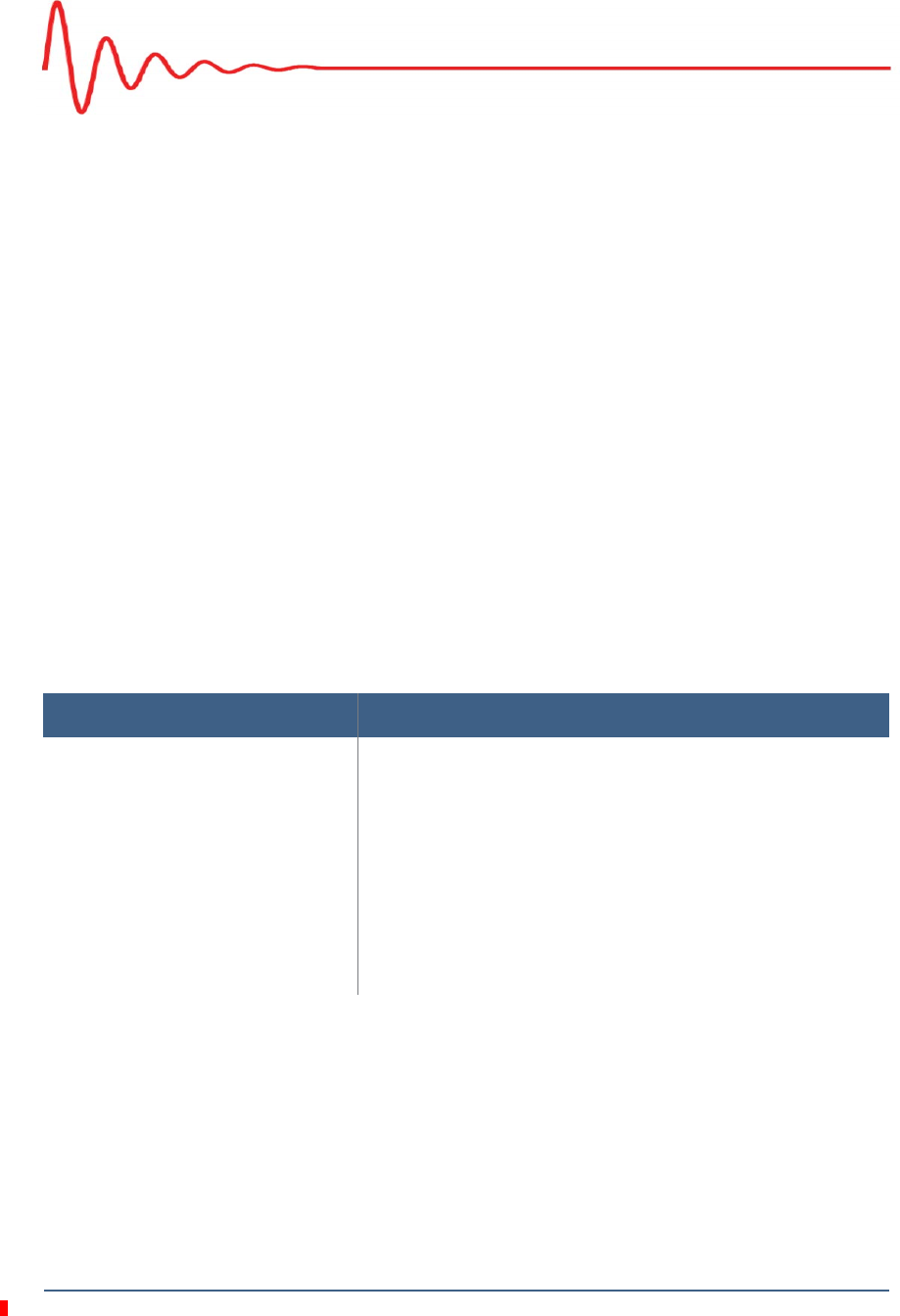Wireless Seismic 00400 Base Station Unit User Manual
Wireless Seismic, Inc. Base Station Unit Users Manual
Users Manual

Draft
RT 1000
Deployment Guide
January 25, 2011
R00.f
Part Number: 90-0004
When Real-time Matters
Wireless Seismic, Inc.
361 Centennial Parkway, Suite 230
Louisville, CO 80027
720.242.9916

Draft
To order additional copies of this document, send an email to your sales representative
requesting the following:
Part Number: 90-0004-PDF
Part Number: 90-0004-Paper
© 2010-2011 Wireless Seismic, Inc. All rights reserved.
All other brands, company names, product names, trademarks or service marks referenced in this material are the
property of their respective owners, who may or may not be affiliated with, connected to, or sponsored by Wireless
Seismic, Inc.
Wireless Seismic, Inc.'s trademarks, registered trademarks or trade dress may not be used in connection with any
product or service that is not the property of Wireless Seismic, Inc., in any manner that is likely to cause confusion
among customers, or in any manner that disparages or discredits Wireless Seismic, Inc. The products and services
described in this material may not be available in all regions.

Draft
RT 1000 v1.0 3 Deployment Guide R00.f
© 2010-2011 Wireless Seismic, Inc. All rights reserved.
Table of Contents
Table of Contents . . . . . . . . . . . . . . . . . . . . . . . . . . . . . . . . . . . . . . . 3
List of Figures 5
List of Tables 6
1. Overview. . . . . . . . . . . . . . . . . . . . . . . . . . . . . . . . . . . . . . . . . . . . 7
1.1 About this Guide . . . . . . . . . . . . . . . . . . . . . . . . . . . . . . . . . . . . . . . . . . 7
1.2 Who Should Use this Guide. . . . . . . . . . . . . . . . . . . . . . . . . . . . . . . . . . . 7
1.3 Other Documents . . . . . . . . . . . . . . . . . . . . . . . . . . . . . . . . . . . . . . . . 12
1.4 Getting Help . . . . . . . . . . . . . . . . . . . . . . . . . . . . . . . . . . . . . . . . . . . . 12
2. Layout. . . . . . . . . . . . . . . . . . . . . . . . . . . . . . . . . . . . . . . . . . . . . .14
2.1 Overview . . . . . . . . . . . . . . . . . . . . . . . . . . . . . . . . . . . . . . . . . . . . . . 14
2.2 Mobilization . . . . . . . . . . . . . . . . . . . . . . . . . . . . . . . . . . . . . . . . . . . . 14
2.2.1 Prerequisites. . . . . . . . . . . . . . . . . . . . . . . . . . . . . . . . . . . . . . . . 14
2.2.2 Getting Ready. . . . . . . . . . . . . . . . . . . . . . . . . . . . . . . . . . . . . . . 14
2.3 At the Site . . . . . . . . . . . . . . . . . . . . . . . . . . . . . . . . . . . . . . . . . . . . . 15
2.3.1 Set Up the Dog House . . . . . . . . . . . . . . . . . . . . . . . . . . . . . . . . . 15
2.3.2 Laying Out the Equipment . . . . . . . . . . . . . . . . . . . . . . . . . . . . . . 16
2.3.2.1 Prerequisites. . . . . . . . . . . . . . . . . . . . . . . . . . . . . . . . . . . . 16
2.3.2.2 Placing the Equipment in the Field . . . . . . . . . . . . . . . . . . . . . 16
2.3.2.2.1 WRU. . . . . . . . . . . . . . . . . . . . . . . . . . . . . . . . . . . . . . 16
2.3.2.2.2 BSU . . . . . . . . . . . . . . . . . . . . . . . . . . . . . . . . . . . . . . 16
2.3.2.2.3 LTU . . . . . . . . . . . . . . . . . . . . . . . . . . . . . . . . . . . . . . 16
2.3.2.2.4 Geophone . . . . . . . . . . . . . . . . . . . . . . . . . . . . . . . . . . 16
3. Software . . . . . . . . . . . . . . . . . . . . . . . . . . . . . . . . . . . . . . . . . . . .17
3.1 Overview . . . . . . . . . . . . . . . . . . . . . . . . . . . . . . . . . . . . . . . . . . . . . . 17
3.2 Installing the Software. . . . . . . . . . . . . . . . . . . . . . . . . . . . . . . . . . . . . 17
3.3 Upgrading the Software . . . . . . . . . . . . . . . . . . . . . . . . . . . . . . . . . . . . 17
3.4 Upgrading the Firmware. . . . . . . . . . . . . . . . . . . . . . . . . . . . . . . . . . . . 17
4. Testing and Maintaining the Equipment . . . . . . . . . . . . . . . . . . . .18
4.1 Overview . . . . . . . . . . . . . . . . . . . . . . . . . . . . . . . . . . . . . . . . . . . . . . 18
4.2 Testing the Layout. . . . . . . . . . . . . . . . . . . . . . . . . . . . . . . . . . . . . . . . 18
4.2.1 Line Tests. . . . . . . . . . . . . . . . . . . . . . . . . . . . . . . . . . . . . . . . . . 18
4.2.2 Source Control Tests . . . . . . . . . . . . . . . . . . . . . . . . . . . . . . . . . . 19
4.2.3 Acquisition Parameter Testing. . . . . . . . . . . . . . . . . . . . . . . . . . . . 20
4.2.4 Built-In-Self-Test (BIST) . . . . . . . . . . . . . . . . . . . . . . . . . . . . . . . 21

Draft
4 RT 1000 v1.0 Deployment Guide R00.f
© 2010-2011 Wireless Seismic, Inc. All rights reserved.
Table of Contents
4.3 Maintaining the Equipment . . . . . . . . . . . . . . . . . . . . . . . . . . . . . . . . . .22
4.3.1 Units. . . . . . . . . . . . . . . . . . . . . . . . . . . . . . . . . . . . . . . . . . . . . .22
4.3.2 Antennas. . . . . . . . . . . . . . . . . . . . . . . . . . . . . . . . . . . . . . . . . . .22
4.3.3 Geophones . . . . . . . . . . . . . . . . . . . . . . . . . . . . . . . . . . . . . . . . .22
4.3.4 Cautions . . . . . . . . . . . . . . . . . . . . . . . . . . . . . . . . . . . . . . . . . . .22
5. Rolling the Line . . . . . . . . . . . . . . . . . . . . . . . . . . . . . . . . . . . . . . 23
5.1 Overview. . . . . . . . . . . . . . . . . . . . . . . . . . . . . . . . . . . . . . . . . . . . . . .23
5.2 Process . . . . . . . . . . . . . . . . . . . . . . . . . . . . . . . . . . . . . . . . . . . . . . . .23
6. Demobilization. . . . . . . . . . . . . . . . . . . . . . . . . . . . . . . . . . . . . . . 24
6.1 Overview. . . . . . . . . . . . . . . . . . . . . . . . . . . . . . . . . . . . . . . . . . . . . . .24
6.2 Process . . . . . . . . . . . . . . . . . . . . . . . . . . . . . . . . . . . . . . . . . . . . . . . .24
7. Troubleshooting. . . . . . . . . . . . . . . . . . . . . . . . . . . . . . . . . . . . . . 25
7.1 Overview. . . . . . . . . . . . . . . . . . . . . . . . . . . . . . . . . . . . . . . . . . . . . . .25
7.2 Specifications. . . . . . . . . . . . . . . . . . . . . . . . . . . . . . . . . . . . . . . . . . . .25
7.2.1 Ground Units: . . . . . . . . . . . . . . . . . . . . . . . . . . . . . . . . . . . . . . .25
7.2.2 Central Server: . . . . . . . . . . . . . . . . . . . . . . . . . . . . . . . . . . . . . .26
7.2.3 Battery Charger: . . . . . . . . . . . . . . . . . . . . . . . . . . . . . . . . . . . . .26
7.2.4 Batteries: . . . . . . . . . . . . . . . . . . . . . . . . . . . . . . . . . . . . . . . . . .26
7.3 LED Chart . . . . . . . . . . . . . . . . . . . . . . . . . . . . . . . . . . . . . . . . . . . . . .27
8. Legal Information . . . . . . . . . . . . . . . . . . . . . . . . . . . . . . . . . . . . 29
8.1 FCC Rules and Regulations Compliance. . . . . . . . . . . . . . . . . . . . . . . . . .29
Glossary. . . . . . . . . . . . . . . . . . . . . . . . . . . . . . . . . . . . . . . . . . . . . . 31
Index. . . . . . . . . . . . . . . . . . . . . . . . . . . . . . . . . . . . . . . . . . . . . . . . 33

Draft
6 RT 1000 v1.0 Deployment Guide R00.f
© 2010-2011 Wireless Seismic, Inc. All rights reserved.
List of Tables
List of Tables
Table 1–1 Roles and Responsibilities ..................................................................7
Table 8–1 Antenna Specifications..................................................................... 29

Draft
RT 1000 v1.0 7 Deployment Guide R00.f
© 2010-2011 Wireless Seismic, Inc. All rights reserved.
1
Overview
1.1 About this Guide
This document provides information on how to deploy the RT 1000 in the field.
1.2 Who Should Use this Guide
The following table describes the typical seismic data acquisition users. The
expected users of this document are as follows:
Crew (Layout/Juggies)
Technician (LTU)
Troubleshooter
Bosses (Line Crew)
Table 1–1 Roles and Responsibilities
Role Responsibility
Bosses (Line Crew) Responsibilities:
• Supervise line crew personnel (juggies)
• Drive and maintain the trucks used to transport
personnel and equipment to and from field operations
• Co-ordinate crew members boarding and exiting
helicopters
• Arrange the safe and orderly transport of equipment.
Reports to:
• Coordinator (Staging)
NOTE: May occasionally visit the doghouse for clarification
of instructions or updates on line status.

Draft
8 RT 1000 v1.0 Deployment Guide R00.f
© 2010-2011 Wireless Seismic, Inc. All rights reserved.
Overview
Who Should Use this Guide
Coordinator (Staging Coordinator
/ Landing Zone (LZ) Coordinator) Responsibilities:
• Journey management of all vehicles (including
helicopters) and personnel to specific points within the
prospect
• Knowledge of all personnel in the prospect; knows when
anyone enters or leaves the prospect, and where they
go when they are there
• Ensures that ground electronics (bag drops) arrive at
the proper location
• Controls inventory and general maintenance of
equipment
• Maintains constant contact with the crew and recorder
• Oversees the testing of fresh equipment to be staged
for the next layout.
Reports to:
•TBD
NOTE: This role may be split in two, one person
coordinating helicopter operations, and the other
coordinating all line crew operations.
Coordinator (Survey) Responsibilities:
• Manages the survey crews. Survey work takes place in
advance of the seismic crew, sometimes weeks or even
months ahead of seismic crew mobilization.
• Attempts to flag or stake every point starting with the
planned receiver and source coordinates (delivered by
the Oil Company Geophysicist or Birddog)
• Adjusts flags or stakes when necessary based on
physical accessibility (whether or not a vibrator or drill
rig can get to a location), permitted corridor, and
archeological or wildlife exclusion zones
• Flags all access points and roads (in cooperation with
the Staging Coordinator)
• Delivers the actual coordinates to the Observer to be
loaded into the Central Recording System
• Provides updates to these coordinates during the project
if ground conditions or permit conditions change
• Ensures that the Central Recording System is configured
with the correct datum and projection information
Reports to:
•TBD
Crew (Layout/Juggies) Responsibilities:
• Lay out the ground electronics
• Pick up the ground electronics
Reports to:
•TBD
Table 1–1 Roles and Responsibilities (cont.)
Role Responsibility

Draft
R00.f RT 1000 v1.0 Deployment Guide 9
© 2010-2011 Wireless Seismic, Inc. All rights reserved.
Overview
Who Should Use this Guide
Crew (Source) Responsibilities:
• Operators drive the vibrator trucks
• Licensed shooters set off the dynamite
• All crew remain in constant voice and data
communication with the recorder during production
NOTE: The source on a land seismic survey is usually either
vibroseis or dynamite. Other source types such as
poulter charges, accelerated weight drops, or
shotguns may be used as well. One job may have
multiple source types due to access or permit
issues, such as steep slopes, masonry construction,
and so on.
Reports to:
•TBD
Drillers Responsibilities:
• Drill source holes
• May also load charge into the hole
Reports to:
•TBD
Geophysicist (Oil Company) Responsibilities:
• Survey design
• Budget
• Delivery of the final data to the Oil Company
• Makes final decisions on recording parameters with the
help of the Birddog
• Visits the field once or twice during the project
• Works closely with the Birddog to protect the interests
of the Oil Company
NOTE: The Geophysicist likely works on either an asset
team responsible for oil or gas production in the
field where the seismic shoot is taking place, or on a
technical team responsible for all the company’s
seismic activity.
Reports to:
•TBD
HSE Manager Responsibilities:
• Ensures the health and safety of every person on the
prospect
• Ensures there is minimal environmental impact
• Verifies that all environmental regulations are followed
• Maintains any medical facilities in the field, such as a
small first-response clinic or ambulance
• Visits the Doghouse infrequently
• Helps with the HSE component of the daily and final
reports
Reports to:
•TBD
Table 1–1 Roles and Responsibilities (cont.)
Role Responsibility

Draft
10 RT 1000 v1.0 Deployment Guide R00.f
© 2010-2011 Wireless Seismic, Inc. All rights reserved.
Overview
Who Should Use this Guide
Observer Responsibilities:
• Primary operator of the Central Recording System
• Works in the Doghouse full-time
• Coordinates all field activities during production
• Monitors the status of the ground electronics
• Organizes troubleshooting activities
• Performs daily and monthly equipment tests
• Controls source activation (vibrators, dynamite, and
others)
• Ensures the quality of the recorded data
• Documents the recording operations
• Determines, with the Staging Manager, which ground
electronics need to be laid out and picked up in advance
of or following source production
• Remains aware of contractual obligations and works
with the Crew to enforce them
Reports to:
•TBD
Observer (Junior/JO) Responsibilities:
• Usually an Observer-in-training, and will take over the
Observer’s role when the Observer is taking a break
• May also be the primary user of the voice radios in
coordinating the operations
• Works in the Doghouse nearly full-time
Reports to:
•TBD
Observer (Senior/SO) Responsibilities:
• Supervises overall seismic operations in the absence of
the Party Manager
Reports to:
•TBD
Office Clerk Responsibilities:
• Maintains an office in the hotel or camp
• Coordinates shipping to and from the field
• Coordinates data delivery
• Reports on deliveries
• Meets with the Party Manager, Observer, and HSE
manager at the end of each shift to provide detailed
information for daily reporting
Reports to:
•TBD
Table 1–1 Roles and Responsibilities (cont.)
Role Responsibility

Draft
R00.f RT 1000 v1.0 Deployment Guide 11
© 2010-2011 Wireless Seismic, Inc. All rights reserved.
Overview
Who Should Use this Guide
Oil Company representative
(Birddog) Responsibilities:
• Makes independent observations and reports directly to
the Oil Company, acting as oversight
• Ensures that the contract is followed and that the
seismic crew is always acting in the best interest of the
Oil Company
• A frequent visitor to the doghouse, keeps informed on
all HSE and production statistics by over-the-shoulder
observation of and conversations with the Observer
• Often walks the line to ensure that geophones are
properly coupled to the ground (planted), and ensures
that the Observer is performing regular Quality Control
(QC) of noise, leakage and geophone response (used to
detect bad plants).
Reports to:
• Oil Company
NOTE: The Birddog is either an employee of the Oil
Company or is contracted directly by the Oil
Company. He is often trained as a Geophysicist, and
has frequently worked as an Observer, surveyor, or
party chief in the past.
Party Manager / Party Chief Responsibilities:
• Leads the seismic crew; responsible for all operations
• Acts as the primary point of contact for the Birddog
• Maintains awareness of all HSE and data quality
activities
• Maintains focus on maximizing production and
minimizing costs
• A frequent visitor to the doghouse, keeps informed on
all HSE and production statistics by over-the-shoulder
observation of and conversations with the Observer
Reports to:
•TBD
Technician (LTU) Responsibilities:
• Builds and maintains the backhaul network using a
ruggedized laptop or tablet PC running the Hardened Rib
Application (HRA). This application has some of the
functionality of the CSS, but streamlined for use as a
troubleshooting tool.
• In frequent communication with the Doghouse
Reports to:
•TBD
Table 1–1 Roles and Responsibilities (cont.)
Role Responsibility

Draft
12 RT 1000 v1.0 Deployment Guide R00.f
© 2010-2011 Wireless Seismic, Inc. All rights reserved.
Overview
Other Documents
1.3 Other Documents
All RT 1000 documents are described in the RT 1000 Documents Guide (P/N 90-
0001).
1.4 Getting Help
To get help on the RT 1000 Central Recording System, consult the online help. You
can find the help documents by clicking the help icon in the user interface, or by
navigating to the following directory:
Directory Path TBD
To get help on the RT 1000 deployment, consult this document.
If you cannot find the answers you need, please contact Wireless Seismic, Inc.
Technical Support at:
361 Centennial Parkway, Suite 230
Louisville, CO 80027
(720) 242-9916
13100 Southwest Freeway, Suite 150
Sugar Land, TX 77478
(832) 532-5080
support@wirelessseismic.com
Technician (Vibrator) Responsibilities:
• Maintains the mechanical and electronic health of the
vibrators
• Visits the Doghouse at job startup to set up the source
controller communications and parameters
• Returns to the Doghouse as maintenance requires
Reports to:
•TBD
Troubleshooters Responsibilities:
• Frequently visits the Doghouse to obtain a
troubleshooting report (either printed or a file that can
be loaded to a GPS device), which contains line/station
numbers of failures as well as verbal instructions from
the Observer.
• Corrects ground equipment failures
Reports to:
•Observer
Table 1–1 Roles and Responsibilities (cont.)
Role Responsibility

Draft
R00.f RT 1000 v1.0 Deployment Guide 13
© 2010-2011 Wireless Seismic, Inc. All rights reserved.
Overview
Getting Help
Note:
Right now, a BSU is a standalone connection to a communication backhaul, power
over ethernet box, and battery.
Ideally, everything would be in one box called the LTU:
WSU
●BSU
●PoE
●Battery
●Backhaul Unit (mast)

Draft
RT 1000 v1.0 14 Deployment Guide R00.f
© 2010-2011 Wireless Seismic, Inc. All rights reserved.
2
Layout
2.1 Overview
This chapter describes how to prepare (mobilization) and layout (install) the
ground electronics.
2.2 Mobilization
2.2.1 Prerequisites
Define
Survey
Back haul plan
other?
2.2.2 Getting Ready
Possible topics for this section (basically collect all the pieces you need for the
job):
List of WS equipment:
●WRU
●LTU
●BSU
●Antennas
●Geophones
●Batteries
NOTE
Please refer to Table 8–1 Antenna Specifications, on page 29 for the list
of supported antennas. Use of accessories other than those specified in
this document is not supported or warrantied.

Draft
R00.f RT 1000 v1.0 Deployment Guide 15
© 2010-2011 Wireless Seismic, Inc. All rights reserved.
Layout
At the Site
►Charging batteries
–Charging Rack/# of batteries (10?)
–Charging Times
●Updating software in the central and ground units (maybe refer them to the
sw chapter).
List of non-WS equipment:
●Dog House
►power source (diesel, benzene or other type of fueled generator)
►heating, cooling and ventilation system
►antenna masts for voice radio, data telemetry, source control, and
possibly satellite phone and/or internet
►shock-mounted rack for PC, displays, servers, network devices, output
devices, etc.
►thermal plotter or equivalent
►desk, chairs, small refrigerator and coffeepot
●Safety equipment (vests, hard hats, etc.)
●Computer, Monitors, Keyboard, Mice, etc.
►Installing and testing interfaces
●HHU? Is there a hand-held unit? (not currently)
●Source controllers?
●Other 3rd party equipment?
●Shot equipment?
●Two-way radios
Preparing the equipment
Making any equipment modifications
Transporting equipment to the site
●Best practices
2.3 At the Site
Prepare the Dog House / CSS HW & SW while the units (sensors & WRUs) are
being placed in the field.
2.3.1 Set Up the Dog House
Set up the following in the dog house:
●Hardware
●Central Server (maybe refer them to the SW chapter)

Draft
16 RT 1000 v1.0 Deployment Guide R00.f
© 2010-2011 Wireless Seismic, Inc. All rights reserved.
Layout
At the Site
2.3.2 Laying Out the Equipment
2.3.2.1 Prerequisites
Define the prerequisites.
The RT 1000 shall be used with only the supplied antennas (Table 8–1 Antenna
Specifications, on page 29) attached to the WRU with an integrated type N male
connector.
The RT 1000 antennas shall be installed and handled by professionals
specifically designated for this purpose.
Changes or modifications not expressly approved by Wireless Seismic, Inc. can
void the users’s authority to operate the equipment.
2.3.2.2 Placing the Equipment in the Field
List each piece of equipment with photo and call outs.
2.3.2.2.1 WRU
2.3.2.2.2 BSU
2.3.2.2.3 LTU
2.3.2.2.4 Geophone
WARNING
In order to comply with FCC radio frequency (RF) exposure
requirements, the RT 1000 units must be installed so that a minimum
separation distance of 20 cm is maintained between the antenna(s) and
all persons at all times during normal operation.
TBD
Figure 2–1 WRU

Draft
RT 1000 v1.0 17 Deployment Guide R00.f
© 2010-2011 Wireless Seismic, Inc. All rights reserved.
3
Software
3.1 Overview
xxx
3.2 Installing the Software
xxx
3.3 Upgrading the Software
xxx
3.4 Upgrading the Firmware
xxx

Draft
RT 1000 v1.0 18 Deployment Guide R00.f
© 2010-2011 Wireless Seismic, Inc. All rights reserved.
4
Testing and Maintaining the
Equipment
4.1 Overview
xxx
4.2 Testing the Layout
xxx
the crew is doing roll-on, roll-off acquisition. This means that only part of the
patch, ten lines, needs to be ready in order to begin production
parameter testing, can begin as soon as one line is laid out, connected, and
tested
4.2.1 Line Tests
When the correct geometry has been applied to each WRU and the geometry
accuracy has been confirmed, the Observer will begin line testing. In the
warehouse before mobilization to the field the WRUs may have passed a series
of BISTs (built in self tests), but these will need to be repeated after
deployment. This can be done from the CSS, or can be done “ahead of the
recorder” using an HRA in troubleshooter mode. Possible BISTs:
• Equivalent Input Noise (EIN)
• Total harmonic Distortion (THD)
• Pulse
• Calibration
• Channel gain and phase error
WARNING
In order to comply with FCC radio frequency (RF) exposure
requirements, the RT 1000 units must be installed so that a minimum
separation distance of 20 cm is maintained between the antenna(s) and
all persons at all times during normal operation.

Draft
R00.f RT 1000 v1.0 Deployment Guide 19
© 2010-2011 Wireless Seismic, Inc. All rights reserved.
Testing and Maintaining the Equipment
Testing the Layout
• Spread noise
• Geophone analysis (TBD)
• Pulse
• DC ohms
• DC leakage
• RF health
o Number of retries per unit
o KB/sec ???
o Power deviation (looking for a high Tx power unit)
o Rib throughput acceptable/not
• GPS position/timing QC
These tests should all be repeated at the CSS as communications are established
with deployed nodes. In addition, the following tests should be conducted of the
backhaul communications:
• Backhaul network confirmation (LTU-to-LTU-to-CSS test)
• Backhaul connectivity confirmation (BSU-to-LTU-to-CSS test)
The WRU BISTs can be executed at any time. If run during recording, any tests on
the analog board or geophones will result in zero-ed data for the duration of the
test. This may be desirable if one or more WRUs have reported a problem resulting
in a skip-heal during high-productivity operations (skip-healing or self-healing is
covered in another document). Tests can also be run during a pause in recording,
or be sent to a queue to be automatically executed at the next pause in recording.
Test results are written to the database, and can then be printed or written to a
file, as in the case of delivering daily tests to the Birddog.
Each set of tests will be stored as a parameter set in the tree. The following matrix
illustrates WS’s recommendations for which tests should be run daily and monthly,
and which are parts of continuous system health monitoring
TBD
4.2.2 Source Control Tests
Seismic Source’s Universal Encoder (UE) is targeted to be the first source
controller to be fully integrated with the CSS software. It will be connected to the
CSS HW as part of an Ethernet LAN. The WS recording system shall support the
same source types and configurations as the UE, including dynamite, multiple
simultaneous vibrator fleets, and mixed source acquisition. When the shooters
and/or vibrator tech have readied their sources, the Observer will establish radio
contact, issue shooting commands, and investigate the content of the post-fire
message. Test shots should be recorded, and correct timing, geometry, and header
values should be confirmed. Further information on this workflow is found in the
Production section
Vibrator similarity tests demonstrate the relationship between planned the sweep
configured at the recorder and the measured ground force at the vibrator. This can

Draft
20 RT 1000 v1.0 Deployment Guide R00.f
© 2010-2011 Wireless Seismic, Inc. All rights reserved.
Testing and Maintaining the Equipment
Testing the Layout
be done over the source controller RF interface or when wired directly to the
source controller. Hardwired similarity tests are more accurate, and the results will
need to be compared to radio similarity tests. Similarity tests, as well as pulse
tests to confirm that vibrators are synchronized, will likely need to be conducted at
the beginning of the survey, and at sweep parameter changes. Radio similarities
are conducted more frequently, measuring and recording raw ground-force versus
time and phase versus time. Frequency of tests will be agreed to by the Oil
Company and Seismic Contractor prior to the start of the project.
Dynamite control testing is simpler than vibroseis. Timing between the source
controller and blaster pack can be verified using a storage scope. This is done by
hooking up one scope input to the encoder and the other to each decoder that is to
be used.
4.2.3 Acquisition Parameter Testing
For most surveys, except those where an Oil Company and/or seismic contractor
have extensive local experience, the Oil Company will conduct a series of
parameter tests. This will likely be under a separate pricing scheme in the
contract, and may take a half to several days. In some cases an advance crew will
be sent to an area to perform parameter testing. It may also take place with a
subset of the patch, for example only a single receiver line. The parameters to be
tested may include:
• Dynamite charge size
• Dynamite hole depth
• Dynamite hole array (number of holes and pattern)
• Vibrator array (number of vibrators and pattern)
• Vibrator sweep configuration
o Sweep length
For most surveys, except those where an Oil Company and/or seismic contractor
have extensive local experience, the Oil Company will conduct a series of
parameter tests. This will likely be under a separate pricing scheme in the
contract, and may take a half to several days. In some cases an advance crew will
be sent to an area to perform parameter testing. It may also take place with a
subset of the patch, for example only a single receiver line. The parameters to be
tested may include:
• Dynamite charge size
• Dynamite hole depth
• Dynamite hole array (number of holes and pattern)
• Vibrator array (number of vibrators and pattern)
• Vibrator sweep configuration
o Sweep length

Draft
R00.f RT 1000 v1.0 Deployment Guide 21
© 2010-2011 Wireless Seismic, Inc. All rights reserved.
Testing and Maintaining the Equipment
Testing the Layout
You can record the parameter tests with one live receiver line while the layout
crews are continuing to work on the next nine lines. This way, the parameter
testing won’t consume any potential production time.
You can economize by combining some of the tests.
4.2.4 Built-In-Self-Test (BIST)
• A method will be provided for synchronizing tests across all WLSs
• Tests executed during deployment are for “go/no-go” purposes. The WRU will
perform low-resolution evaluations of deployment tests and indicate the result with
the battery LEDs. This is to save time and power and to reduce the effort required
to write high-resolution evaluation in the WRU
There will be tests to implement in 2 places. We plan a “go no-go” test at the WRU
that will be a simple calculation (not high precision) in order to assess if the
channels and geophones are good. This could be done by Alex or someone like
him. At the BSU application or LTU, the data for each of the test records (some
tests have several records) would be sent from the WRU and processed with
precision and the values for the tests calculated. I have someone that can write
this software. The main reason to do this is when the system is audited the data
and results for the same data, must be provided for analysis. If we do precision
calculations at the WRU it adds complexity and may increase processing
requirements
• Tests executed from the central system are for verifying the WRU specifications.
• WRUs will be commanded to execute internal and/or external tests. The data will
be returned to the base station (in early development) or to the central system for
high-resolution evaluation
Internal
During these tests the Geophone is disconnect electrically for the preamp. An
internal test oscillator (where appropriate) drives the WRU analog channel in order
to measure the characteristics of the Preamplifier and A/D. These tests should be
run prior to running the external tests.
• Equivalent Input Noise (EIN)
• Total Harmonic Distortion THD
• Pulse
Calibration
• Channel Gain error and Phase error
B. External
During these tests the geophone is connected to the preamplifier and test circuitry
for the purpose of measuring and characterizing the planted geophone. These

Draft
22 RT 1000 v1.0 Deployment Guide R00.f
© 2010-2011 Wireless Seismic, Inc. All rights reserved.
Testing and Maintaining the Equipment
Maintaining the Equipment
tests should be run only after it is established that there are no problems with the
analog channel.
• Spread Noise
• Geophone analysis
• Pulse
• DC Ohms
• DC Leakage
4.3 Maintaining the Equipment
xxx
4.3.1 Units
4.3.2 Antennas
4.3.3 Geophones
4.3.4 Cautions

Draft
RT 1000 v1.0 23 Deployment Guide R00.f
© 2010-2011 Wireless Seismic, Inc. All rights reserved.
5
Rolling the Line
5.1 Overview
xxx
5.2 Process
the crew is doing roll-on, roll-off acquisition. This means that only part of the
patch, ten lines, needs to be ready in order to begin production
Pickup and layout crews will be picking up lines behind production and laying
them out ahead of production. Depending on battery charge state, equipment
may circulate through staging or go directly from one line to the next.
In order to make most efficient use of layout crews, it is common to lay out
entire receiver lines at a time even if they are longer than the template. This
way crews don’t need to spend time walking or driving from one line to the
next picking up or laying out small amounts of equipment. However, if the size
of the survey is large and receivers per line multiplied by the number of lines
is larger than the number of channels available, it may be necessary to roll in
the inline direction. In this case, it is necessary to be able to pick up and lay
out WRUs in quantities smaller than a rib, for example increments of six WRUs.
During inline roll operations, it may be desirable to add newly deployed WRUs
to an existing (discovered) rib. The Observer can instruct the last WRU in a rib
to poll for neighbors during recording. Newly added WRUs can begin recording
immediately.

Draft
RT 1000 v1.0 24 Deployment Guide R00.f
© 2010-2011 Wireless Seismic, Inc. All rights reserved.
6
Demobilization
6.1 Overview
xxx
6.2 Process
xxx
As soon as the Event Manager tool has determined that a WRU is no longer
needed at that location, it will change color on the basemap. The Observer will
need to consider the possibility of reshooting source points, which could
happen if some recording failure is discovered later. Assuming no such
reshoots, the Observer can undeploy the WRU or the entire rib. There will be
no detrimental effect to either the ground electronics or the CSS database if
the pick-up crew starts picking up the line before the Observer has undeployed
it (e.g. if the backhaul is interrupted), as long as the Observer manually
removes the picked-up WRUs from the deployed list at a later date. However,
the preferred procedure for accurate asset tracking is to deploy from the CSS
before physical pick-up.
Another option is for an LTU technician to undeploy a rib using the HRA while
connected into the LTU/BSU. This can only be done when the rib has finished
all recording operations. This requires that a message indicating which WRUs
have been undeployed be sent to the CSS after this action.
Undeployment user action in the CSS can be either from the basemap or from
a spreadsheet listing within the CSS application. An “are you sure” pop-up
should be considered, especially for large numbers of WRUs and certainly for
WRUs that haven’t been cleared by the Event Manager.
Once a WRU or rib is undeployed by the Observer through the CSS, it is up to
the staging manager to ensure the physical pickup and asset tracking of the
ground electronics. At the end of the project, the primary need the Observer
has of the CSS is to ensure that all positional and trace data has been stored,
backed up, and delivered properly. He will then need to power everything
down and secure all hardware for transport.

Draft
RT 1000 v1.0 25 Deployment Guide R00.f
© 2010-2011 Wireless Seismic, Inc. All rights reserved.
7
Troubleshooting
7.1 Overview
xxx
7.2 Specifications
7.2.1 Ground Units:
●In summary, the unit must operate (from a power off condition) with an
internal temperature ranging from -50C to +85C. The box performance
specifications will be over the usual range of -40C to +70C.
●The system shall survive immersion in fresh or salt water (maximum of
5 m) for up to 1 day and still function to specification.
●The unit is not expected to operate at depth, but it should not corrode
when submersed with battery packs. If the unit is self buoyant it will
still be subjected to the test by forced submersion.
●The system shall survive a 2 meter drop onto ¾ inch plywood on
concrete on any surface of the unit.
●This is the standard used by seismic manufacturer. Units will throw to
the ground and into the back of trucks and they must be able to
withstand this kind of shock
●The system shall have a removable antenna and still maintain its water
seal with the antenna removed
●The system shall have removable desiccant packs inside enclosures
●The WRU shall meet all system requirements after being opened and
closed for repair or maintenance in 95% humidity, 38°C environments.
●The battery pack shall have a shelf life of 1 year before needing a
recharge
●A LI-Ion cell at about 60% to 80% charge level it should last at least 12
months when kept at 23°C. This will reduce to about 3 - 6 months at
40°C and 1 - 3 months at 60°C.
●The battery pack shall have minimum of 48 watt hours of capacity

Draft
26 RT 1000 v1.0 Deployment Guide R00.f
© 2010-2011 Wireless Seismic, Inc. All rights reserved.
Troubleshooting
Specifications
●Battery must comply with runtime of unit. Two battery packs at minimum
capacity should run the system for the required time (at 25C?). A cold
temperature battery pack could be made available; for example, 8-10 cells.
7.2.2 Central Server:
●The central hardware shall have an operating range of 5°C to 55°C.
●The central hardware shall have adequate cooling to keep internal heat rise
within 5 degrees of ambient.
●The central hardware shall operate on AC voltage with an input range of 84
– 260 volts at 50 to 60 hertz.
●The central hardware shall be capable of operating in a dusty environment
●The central hardware shall be capable of connecting to an industry standard
source controller cable
●Prior to mobilization, the Observer will ensure that the installed CSS
revision is the most recent reliable version available. Unless needed to
replace major system error/defect, the system software should not be
updated during the Survey. In the event of a major recording system
failure, a complete instrument test will be run and operations are not to
resume until tests are approved by the Birddog.
7.2.3 Battery Charger:
●The battery charger shall operate on AC voltage with an input range of 84 –
260 volts at 50 to 60 hertz.
Some power conditioning may be required for use with generators.
●The battery charger shall have an operating range of 5°C to 55°C
●The battery charger module should be capable of running on a standard 20
amp breaker (@120 volts) with the charger fully loaded
7.2.4 Batteries:
●When two batteries are attached the WRU will choose the battery with the
lowest acceptable charge. This battery will be used until it is completely
discharged to a defined value then the WRU will switch ports and flash the
appropriate LEDs to notify the crew which battery is in use and which needs
to be replaced.
●When a second battery is not available, the WRU will discharge the battery
until the regulator can no longer supply proper voltage to the watchdog or
the battery pack protection circuit shuts off the battery at 2.8V
●If a battery is discharged to point the pack protection board shut the
battery off, the battery pack should be charged within two weeks of this
occurrence

Draft
R00.f RT 1000 v1.0 Deployment Guide 27
© 2010-2011 Wireless Seismic, Inc. All rights reserved.
Troubleshooting
LED Chart
7.3 LED Chart
Insert the chart showing possible LED situations and what they mean.
Throughout the project, there will likely be intermittent problems with the ground
electronics. Failures can result from poor initial deployment, general wear and tear,
lighting strikes or other acts of god, livestock and wildlife, or vandalizing (or
curious) humans. When these problems must be solved physically, the Observer
will use troubleshooters. Battery replacements fall into this category as well, if only
an anomalous few need to be replaced within the spread.
The troubleshooters, as noted in the User Story section, will have quick
transportation (usually a mule or ATV), a collection of spares and tools, and a
reasonable level of technical skill and training. The Observer will provide him with
a printed list or file that can be loaded to a GPS. It will include:
• Location (X/Y and line/station)
• Faulty piece of equipment (geophone string, LTU/BSU, WRU)
• Nature of problem (GPS failed, dead battery)
• Prioritization
As each issue is addressed, the troubleshooter will communicate the action to the
Observer. At any point after this communication, the Observer will want to issue a
command to the WRU in question, such as battery or geophone test. This can be
issued immediately, tests that involve the analog circuit will result in zero-ed data
from that WRU for as long as the test takes. It can also be sent to a queue, where
the command is sent automatically when there is a pause in production. This is a
part of the event management tool. This queue also handles duty cycle issues-
where a WRU power state requires commands to wait for a particular interval.
When a WRU has failed, the rib will automatically skip-heal. This means that
adjacent WRUs will communicate around the dead WRU, so that recording can
continue uninterrupted. If a troubleshooter replaces or repairs the WRU, re-
creation of the rib can only happen when production is paused. This can be done
on command, or can be queued as with other testing commands.
In addition to troubleshooting reports, the Observer will be able to generate a
battery report. This will contain all health information about any battery that has
sent data to the CSS. Indexed by line/station or serial number, it will report the
number of charge cycles, current charge state, and any other available statistics.
Troubleshooting
• All troubleshooting functions will be performed in the active and not the
acquiring state
• The units must be commanded to stop sending seismic data; however the cycle-
mode will remain active to facilitate the troubleshooting process.

Draft
28 RT 1000 v1.0 Deployment Guide R00.f
© 2010-2011 Wireless Seismic, Inc. All rights reserved.
Troubleshooting
LED Chart
• The CRA will contain functions that can be used with a BSU to perform the
following on demand tests:
o No GPS position
Position is invalid because not enough satellites were acquired. This should only
need to be done at initial WLS discovery. GPS should not be turned on when
analog is on. Operator should be able to turn on the GPS receiver for a specified
time. If no position can be determined then the operator should be able to review
the neighbor information to determine the unit’s line and station and manually set
it in the application.
o WRU replacement (user initiated)
A unit may need to be replaced for any number of reasons determined by the
operator. The uplink and downlink neighbor of the unit being replaced would be
told that its neighbor is being changed and it (downlink unit) should be sent an
undeploy command by serial number. Once the replacement WRU has been
changed, this unit should be activated by troubleshooter and it will execute the self
and neighbor discovery process. The uplink and downlink neighbors of the
replacement WRU should perform a WLS discovery with the new unit and add it to
the list of units in WLS.
o Geophone troubleshooting
This is a case where a geophone has been identified as bad and there is a
troubleshooter at the unit. Select the units and perform any geophone test
available. These tests can be run as a suite or individually. The units) would need
to be told to turn on analog power and would begin to send data to CRA for
analysis. For more detail on analyzing test data see “WRU built in self tests”.
o Battery management
This test when a battery is to be replaced and tested to verify that it is a good
battery. Select the unit and request battery status the WRU. Display data for both
batteries if present.
o Analog channel evaluation
This test is performed when a geophone has been replaced with a new one and
test is still bad. Run the internal tests to determine if the channel is bad and the
WRU needs to be replaced. These tests can be run as a suite or individually. The
units) would need to be told to turn on analog power and would begin to send data
to CRA for analysis. For more detail on analyzing test data see “WRU built in self
tests”.
o Deployment test with tolerance parameters on demand
In the active state, propagate a command downlink in the heartbeat to an
individual WRU to run the go-no-go test suite with a specified tolerance and
indicate on LEDs test results and report pass/fail to the WS manager in next
heartbeat.
Note special care will have to be taken with tilt switches during battery
replacement. A user-gesture may be used to assist this process.

Draft
RT 1000 v1.0 29 Deployment Guide R00.f
© 2010-2011 Wireless Seismic, Inc. All rights reserved.
8
Legal Information
8.1 FCC Rules and Regulations Compliance
The Federal Communications Commission (FCC) regulates the use of antennas
in the “Code of Federal Regulations – Title 47, Part 15 – Radio Frequency
Devices, Subpart C – Intentional Radiators, Section 15.203 Antenna
Requirement.”
When used as intended, the RT 1000 complies with FCC Section 15.203
requirements as follows:
The RT 1000 antennas shall be installed and handled by professionals
specifically designated for this purpose.
Changes or modifications not expressly approved by Wireless Seismic, Inc.
can void the users’s authority to operate the equipment.
The RT 1000 shall be used with only the supplied antennas (Table 8–1)
attached to the WRU with an integrated type N male connector.
NOTE
This equipment has been tested and found to comply with the limits for
a Class A digital device, pursuant to part 15 of the FCC Rules. These
limits are designed to provide reasonable protection against harmful
interference when the equipment is operated in a commercial
environment. This equipment generates, uses, and can radiate radio
frequency energy and, if not installed and used in accordance with the
instruction manual, may cause harmful interference to radio
communications. Operation of this equipment in a residential area is
likely to cause harmful interference in which case the user will be
required to correct the interference at his own expense.
Table 8–1 Antenna Specifications
Model Frequency
(MHz) Gain Vertical
Bandwidth Weight Dimension
(Length x
Diameter)
WSI 65-0023 2400-2485 5 dBi 25º 0.5 lbs
0.2 kg 12 x 0.6 in
355 x 15 mm
WSI 6060-001-01 2400-2485 7 dBi 18° 0.6 lbs
0.3 kg 21 x 0.6 in
540 x 15 mm

Draft
30 RT 1000 v1.0 Deployment Guide R00.f
© 2010-2011 Wireless Seismic, Inc. All rights reserved.
Legal Information
FCC Rules and Regulations Compliance
WSI 65-0025 2400-2485 2 dBi @ 2.4 120° 1.6 oz
45.4 g 7.6 x 0.5 in
193 x 12.7 mm
Table 8–1 Antenna Specifications (cont.)
Model Frequency
(MHz) Gain Vertical
Bandwidth Weight Dimension
(Length x
Diameter)
WARNING
In order to comply with FCC radio frequency (RF) exposure
requirements, the RT 1000 units must be installed so that a minimum
separation distance of 20 cm is maintained between the antenna(s) and
all persons at all times during normal operation.

Draft
RT 1000 v1.0 31 Deployment Guide R00.f
© 2010-2011 Wireless Seismic, Inc. All rights reserved.
Glossary
channels/line 288
channels/patch 4608
crossline size 52800 ft
inline size 31680 ft
lines/patch 16
describe the shooting template
the number of lines that should be live
max inline offset 13200 ft
The “max inline offset” is the longest raypath, or lateral distance
between source and receiver, desired for the imaging target. This
describes half the inline (receiver line) length of the recording
template.
receiver interval 110 ft
describe the basic geometry of the points on the ground- the
spacing of points on a line and the spacing of the lines
themselves
receiver line interval 1650 ft
describe the basic geometry of the points on the ground- the
spacing of points on a line and the spacing of the lines
themselves
receiver lines 32
roll-on / roll-off 10 lines
source interval 220 ft
describe the basic geometry of the points on the ground- the
spacing of points on a line and the spacing of the lines
themselves

Draft
32 RT 1000 v1.0 Deployment Guide R00.f
© 2010-2011 Wireless Seismic, Inc. All rights reserved.
Glossary
source line interval 1760 ft
describe the basic geometry of the points on the ground- the
spacing of points on a line and the spacing of the lines
themselves
source lines 18
swath width 3 lines
describe the shooting template
the number of continuous source points that will be shot into a
live patch
swath width of three lines means that three receiver line’s worth
of source points will be shot before the source crews move down
the receiver line and continue the other direction on the next
source line

Draft
RT 1000 v1.0 33 Deployment Guide R00.f
© 2010-2011 Wireless Seismic, Inc. All rights reserved.
Index
A
antenna
specifications 29
antennas 29
B
birddog 11
bosses
line crew 7
C
contact 12
coordinator
landing zone 8
staging 8
survey 8
crew
juggies 8
layout 7, 8
source 9
D
documents 12
drillers 9
F
FCC 29
Section 15.203 29
G
geophysicist
oil company 9
H
help 12
HSEmanager 9
J
JO 10
juggies 7
L
LZ Coordinator 8
M
modifications 29
O
observer 10
junior 10
senior 10
office clerk 10
oil Company representative 11
P
party
chief 11
manager 11
S
SO 10
specifications
antenna 29
supported
antennas 29
T
technician
LTU 7, 11
vibrator 12
troubleshooter 7
troubleshooters 12
U
users 7

Draft
Index
U
34 RT 1000 v1.0 Deployment Guide R00.f
© 2010-2011 Wireless Seismic, Inc. All rights reserved.
